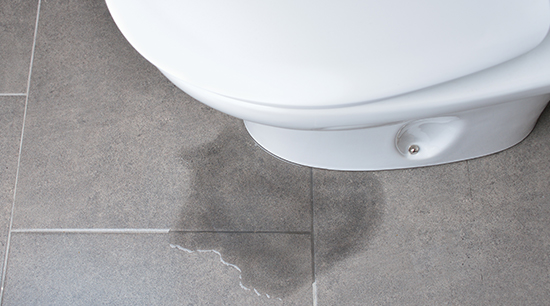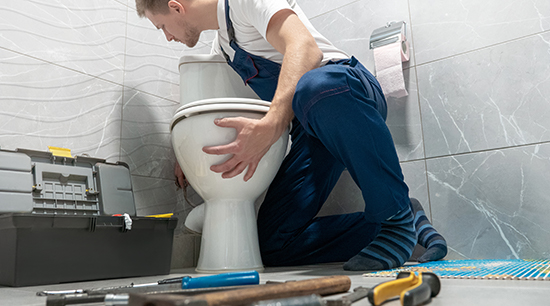Avoid catastrophic water damage, nasty cleanups, and health risks when your toilet starts leaking from the bottom. Knowing how to identify and correct the issue will help you protect your home and safeguard your health.

alpharettawaterdamageremoval.com gathered the following information on how to determine why your toilet is leaking from the bottom and get it repaired before it can cause more severe issues.
Why is My Toilet Leaking from The Bottom?
This leak type is usually caused when the seal under the toilet fails. This wax ring can be broken when one of the flanges (bolts) cracks and causes the toilet to become unstable. Below you’ll learn how to install a new wax gasket to create a watertight seal between the toilet and the closet flange and install a new flexible water-supply tube.
Note: Sudden shifts, impacts, sewage backup, and poor installation can all result in water overwhelming the wax seal located beneath the toilet.
How to Repair a Toilet Leaking from the Bottom

Before purchasing a new wax ring for your toilet, you must determine the cause of the leak. Water can damage the floor or subfloor and weaken the mounting bolts attaching the toilet flange and the toilet to the floor. Determine whether or not you need to cut away the damaged flooring or subfloor, replace the mounting bolts, replace the wax ring, or all of the above. Once you’ve determined the extent of the problem, consider the following steps:
- Drain the Toilet Tank and Bowl – Turn off the water supply valve and drain the water from the tank and bowl.
- Disconnect the Water Supply Line – Removing the water supply line will help you when resetting the toilet after the wax seal is replaced. You should always consider replacing the toilet supply line when replacing the wax seal. If the toilet is caulked to the bathroom floor, score the caulking all the way around the toilet base with a razor knife.
- Remove the Toilet – Once free, grab the toilet under the sides of the bowl and rock it back and forth to break the old wax seal. Lift the toilet off of the floor and set it aside.
- Remove the Spent Wax Ring – Use a wide putty knife to scrape the old wax seal off the toilet base and toilet flange. Tilt the toilet to remove any residual wax from the bottom.
- Make Necessary Repairs – This is the stage to repair any damaged flooring, bolts, or other parts before laying the new ring in place.
- Install the New Wax Ring – Place the new wax seal centered on top of the toilet flange.
- Re-Install the Toilet – Using the bolts as a guide, lower the toilet as level as possible when placing it onto the new wax seal.
- Secure the Toilet – Install washers and tighten fasteners in the order and location they were removed from.
- Re-attach the Water Source – Connect the water source to the toilet, turn the water on, and let the tank fill before flushing.
- Test Your Work – Place tissues or toilet paper around the bottom of the toilet bowl where it meets the floor (make certain the floor is dry) and flush the toilet several times. If you see water soaking the tissues or paper, the wax seal is not correctly installed (remove the toilet and start the installation over using a new wax seal).
- Finish the Installation – If you do not see any leaks after installing the wax ring, seal the toilet bowl to the floor and thoroughly sanitize the toilet and all bathroom surfaces.
Tip: When re-installing the toilet, the tank should be parallel to the wall. DO NOT rock the toilet as you seat it on the newly installed wax seal. Use a slight side-to-side twisting motion until the fixture rests flush on the bathroom floor.
How Dangerous is Water from a Toilet Leak?

The same categorizations used for floodwater can be used for toilet overflows and leaks. Consider the following before cleaning any water leaking from your toilet:
Category 1 – This is clean water from sanitary sources, or that does not contain significant microbial contaminants. Regarding your toilet, this water would emanate from the source plumbing or the water reserve tank.
Category 2 – Also known as gray water, this water may contain a contamination level able to cause illness or discomfort if ingested. Such sources include:
- Dishwasher or washing machine overflow
- Sump pump failures
- Toilet overflow or leaks with urine but no fecal matter
Category 3 – This is known as black water, and it contains pathogens leaving it highly contaminated and grossly unsanitary. Ingestion can lead to severe illness or death. These sources include:
- Toilet bowl overflows or leaks containing fecal matter
- Sewage backup
- Rising floodwater
Tip: Use protective clothing, gloves, masks, and protective eyewear when handling suspected or confirmed category 3 water.
Fixing Toilet Leaks
In this article, you discovered how to identify the source of your toilet leaking from the bottom and how to get it quickly repaired.
By keeping your toilet functioning as intended, you can prevent costly structural damages and severe health problems for your loved ones.
Ignoring a toilet leaking from the bottom can result in catastrophic structural damage, expensive repairs, and potentially life-threatening illness.
Sources:
19january2017snapshot.epa.gov/www3/watersense/our_water/howto.html
mass.gov/info-details/quick-reference-water-damage-response-in-buildings
fs.utk.edu/wp-content/uploads/2018/06/Plumbing-Workshop-Outline.pdf
(678) 505-0266